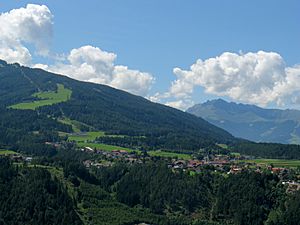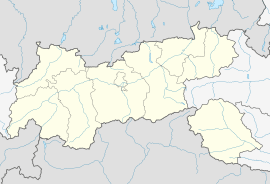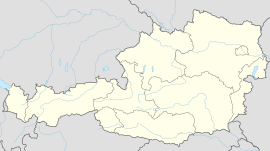Mutters facts for kids
Quick facts for kids
Mutters
|
||
|---|---|---|

Mutters seen from Igls in the east
|
||
|
||
| Country | Austria | |
| State | Tyrol | |
| District | Innsbruck Land | |
| Area | ||
| • Total | 19.03 km2 (7.35 sq mi) | |
| Elevation | 830 m (2,720 ft) | |
| Time zone | UTC+1 (CET) | |
| • Summer (DST) | UTC+2 (CEST) | |
| Postal code |
6162
|
|
| Area code | 0512 | |
| Vehicle registration | IL | |
| Website | www.mutters.tirol.gv.at | |
Mutters is a charming village located in the Innsbruck-Land district. It is found in the beautiful Austrian state of Tyrol. Mutters is only about 4.7 kilometers (3 miles) south of the city of Innsbruck.
This village has a very long history. People first settled here around 3000 years ago! Mutters was officially mentioned in records for the first time in the year 1100.
In 1904, Mutters became much easier to reach. This happened when the Stubaitalbahn train line was built. This train connects Mutters with Innsbruck.
Mutters is also home to the Muttereralmbahn. This is a special cable car system. It helps people get up the mountains for fun activities.
Contents
Exploring Mutters: A Mountain Village
Mutters is a lovely village nestled in the mountains. It offers stunning views of the surrounding Tyrolean Alps. The village is a popular spot for both locals and tourists.
How to Get Around Mutters
The Stubaitalbahn is a historic electric train. It connects Mutters to Innsbruck and other villages. This train makes it easy to travel without a car.
The Muttereralmbahn is a modern cable car. It takes visitors up to the Muttereralm mountain area. In winter, it's great for skiing and snowboarding. In summer, it's perfect for hiking and mountain biking.
Mutters' Long History
Mutters has been a home for people for a very long time. Ancient people lived here thousands of years ago. The first written mention of Mutters was over 900 years ago. This shows its deep roots in the region.
People of Mutters
The number of people living in Mutters has changed over time. In 1869, about 640 people lived here. By 2011, the population had grown to nearly 2000 residents.
| Historical population | ||
|---|---|---|
| Year | Pop. | ±% |
| 1869 | 640 | — |
| 1880 | 667 | +4.2% |
| 1890 | 652 | −2.2% |
| 1900 | 686 | +5.2% |
| 1910 | 824 | +20.1% |
| 1923 | 827 | +0.4% |
| 1934 | 929 | +12.3% |
| 1939 | 982 | +5.7% |
| 1951 | 1,227 | +24.9% |
| 1961 | 1,145 | −6.7% |
| 1971 | 1,441 | +25.9% |
| 1981 | 1,592 | +10.5% |
| 1991 | 1,793 | +12.6% |
| 2001 | 1,933 | +7.8% |
| 2011 | 1,983 | +2.6% |
See Also
 In Spanish: Mutters para niños
In Spanish: Mutters para niños




